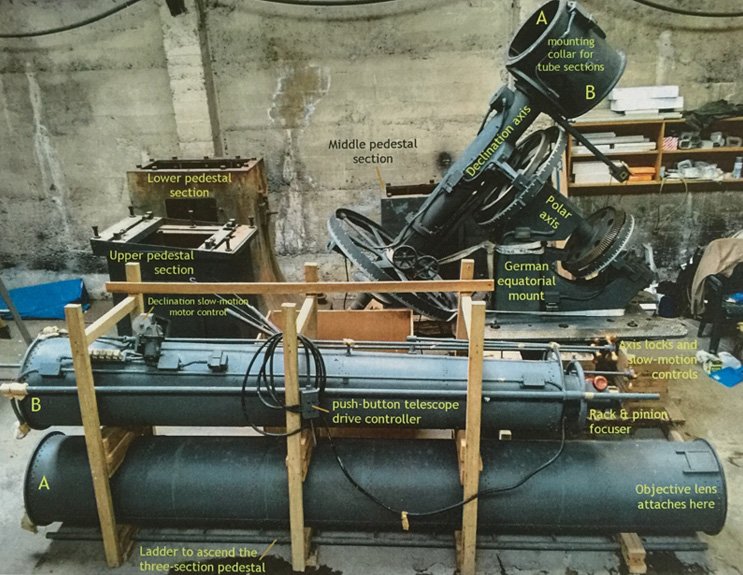The history of the Brashear Telescope
The Brashear Telescope is one of the world’s most famous Victorian telescopes. The 18-inch refractor was created in 1894 by renowned Pennsylvanian Optician, John Brashear, and was fitted in an eight metre long tube atop a 5.4 metre high pier and equatorial mount fabricated by the illustrious Warner & Swasey Co. of Cleveland, Ohio. The telescope was then installed in a ten metre diameter dome at the Flower Observatory, owned by the University of Pennsylvania.
For over half a century, this extraordinary piece of equipment produced a multitude of valuable research data and became hugely important in the history of astronomy. During Percival Lowell’s studies of Mars, he famously used the telescope to see sunlight reflected off the Martian polar icecaps. The Brashear Telescope was also used by Walter Leight in his early examinations of Saturn, where Leight first observed sub-divisions in Saturn’s rings.
The Flower Observatory closed in 1954 and the Brashear Telescope was dismantled and placed into storage. In 1962, the University of Pennsylvania began exploring a Southern Hemisphere astronomy programme and so the telescope arrived in New Zealand and to Tekapo in 1963 in a partnership with the University of Canterbury (UC). This partnership resulted in the establishment of the Mt John Observatory, but unfortunately for the Brashear, there were insufficient funds to build a dome suitable to house the ninemeter tall telescope and it was resigned again to a life in storage. In 2016, UC gifted the telescope to the Tomorrow’s Skies Charitable Trust to enable the long-held dream of restoration to be realised.
For over half a century, this extraordinary piece of equipment produced a multitude of valuable research data and became hugely important in the history of astronomy. During Percival Lowell’s studies of Mars, he famously used the telescope to see sunlight reflected off the Martian polar icecaps. The Brashear Telescope was also used by Walter Leight in his early examinations of Saturn, where Leight first observed sub-divisions in Saturn’s rings.
The Flower Observatory closed in 1954 and the Brashear Telescope was dismantled and placed into storage. In 1962, the University of Pennsylvania began exploring a Southern Hemisphere astronomy programme and so the telescope arrived in New Zealand and to Tekapo in 1963 in a partnership with the University of Canterbury (UC). This partnership resulted in the establishment of the Mt John Observatory, but unfortunately for the Brashear, there were insufficient funds to build a dome suitable to house the ninemeter tall telescope and it was resigned again to a life in storage. In 2016, UC gifted the telescope to the Tomorrow’s Skies Charitable Trust to enable the long-held dream of restoration to be realised.

The Telescope and the Community
The Tomorrow’s Skies Charitable Trust will ensure that the Brashear Telescope is free for the public to view throughout the day, and always will be. The aim is for the telescope to become the anchor of astronomy in Tekapo and to provide thousands of people each year with an experience like no other on earth. Every year, the Trust will also provide 2000 New Zealand school students and their teachers, free access to the Brashear Telescope for schools to take part in astronomy education. This free access will give New Zealand school children the chance to view some of the clearest, darkest night sky in the Southern Hemisphere and the Trust hopes that this extraordinary access will help to foster a new generation of young astronomers.
The Tomorrow’s Skies Charitable Trust’s goal is to restore the Brashear Telescope to perfect working order and build a suitable observatory dome to house it so that it will be readily accessible to the public. The delicate process of restoration will involve exposing the beautiful original brass, steel and wooden finishes, refurbishing all the mechanical components including the five-meter-high equatorial mount and resetting the 18-inch Brashear lens into the telescope tube.
The Brashear Telescope will then be installed in the purpose built dome in the new International Astronomy Centre so it can once again be used after five decades in storage. This dome will be a masterpiece in itself, with a separate foundation and entranceways, as well as viewing platforms and a purpose built gantry crafted to ensure visitors have life-changing experiences.
The Tomorrow’s Skies Charitable Trust’s goal is to restore the Brashear Telescope to perfect working order and build a suitable observatory dome to house it so that it will be readily accessible to the public. The delicate process of restoration will involve exposing the beautiful original brass, steel and wooden finishes, refurbishing all the mechanical components including the five-meter-high equatorial mount and resetting the 18-inch Brashear lens into the telescope tube.
The Brashear Telescope will then be installed in the purpose built dome in the new International Astronomy Centre so it can once again be used after five decades in storage. This dome will be a masterpiece in itself, with a separate foundation and entranceways, as well as viewing platforms and a purpose built gantry crafted to ensure visitors have life-changing experiences.
You can preserve history and support a new generation of southern stargazers
In order to realise the goal of restoring and re-housing the Brashear Telescope, the Tomorrow’s Skies Charitable Trust needs to raise $1.4M. The Trust is committed to securing these funds by the end of 2018 in alignment with the Earth & Sky International Astronomy Centre Project.
We need your support to preserve this masterpiece of astronomical engineering and restore it to perfect working order. The expert hands that will restore the telescope will ensure that every detail is exact and that each facet of the Brashear Telescope remains true to its original makeup. This antique masterpiece deserves to once again be a working telescope that celebrates its history, while allowing a new generation to stargaze through the same telescope lens as the great astronomers of the past.
We need your support to preserve this masterpiece of astronomical engineering and restore it to perfect working order. The expert hands that will restore the telescope will ensure that every detail is exact and that each facet of the Brashear Telescope remains true to its original makeup. This antique masterpiece deserves to once again be a working telescope that celebrates its history, while allowing a new generation to stargaze through the same telescope lens as the great astronomers of the past.

THE BRASHEAR TELESCOPE COMING OUT OF STORAGE
